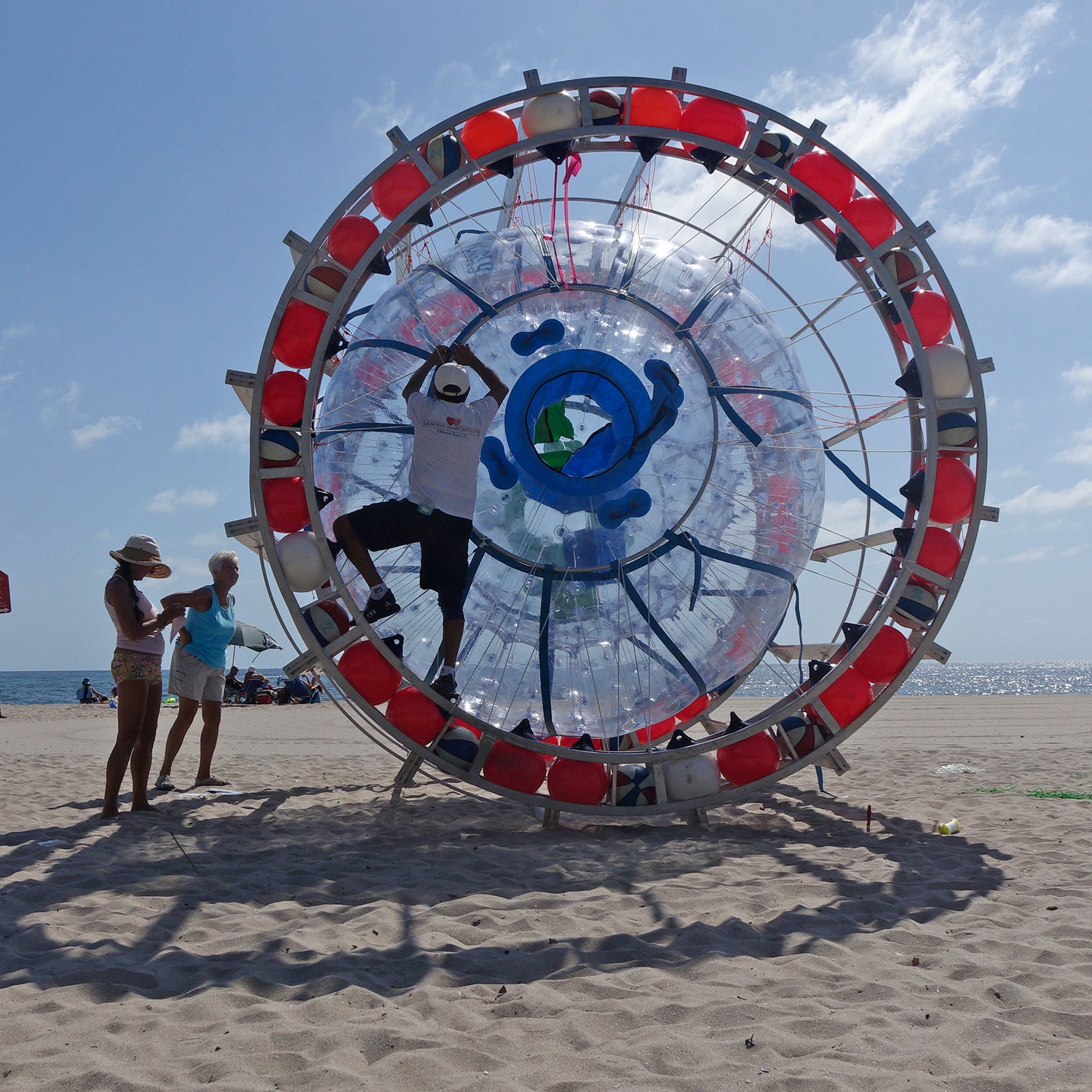When a U.S. Coast Guard cutter picked up Iranian exile-turned-U.S. ultrarunner off the east coast of Florida on April 24, it marked the second time in three years Baluchi failed to run to Bermuda, across the western Atlantic Ocean, in his floating bubble.��
Baluchi was also rescued in 2014, roughly 70 miles east of Florida. Afterward, he maintained his emergency locator beacon went off by accident and that he didn’t need a rescue. “I see some helicopter coming,” Baluchi said at the time. “Some person come in front of my bubble and kick my bubble. ‘You OK? You need emergency doctor? I say, ‘No.’”��
For his most recent attempt, Baluchi planned a 3,500-mile journey, including a trip down to the Caribbean and back up to Florida once he’d hit Bermuda. Almost all of it—up to five months of travel—would take place in the open Atlantic Ocean in his vessel—a modified spherical “zorb,” like those you see kids pushing around a swimming pool, surrounded by a frame consisting of a riverboat wheel-esque propulsion system and 36 buoys affixed to the wheel for flotation. He planned to eat fish he caught with a hand line and drink salt water that he desalinated using a purification system.
Zorbing��across the open ocean—essentially running on water in a giant clear hamster wheel—has intrigued people for years. It works like this: the runner propels the zorb with his feet and hands at roughly one mile per hour, pointing the zorb in whatever direction he wants to go. There is no formal steering system. To date, long-distance pursuits have seen little success. Two months before Baluchi’s latest attempt, a British television host named Lindsey Russell attempted to cross the Irish Sea in a modified zorb similar to Baluchi’s. She was ��by a support boat in bad weather after covering 17 of her intended 21 miles.��
Baluchi’s chances of success?��“Absolutely zero.��You probably would go a thousand miles, but not to where you wanted to go.”
The South Florida Sun-Sentinel ��shortly after Baluchi embarked for the first time on April 13 (he was quickly pushed back to shore by the wind). Among other gems: the 44-year-old trained for his 3,500-miler by jumping rope in a sauna for an hour each day; got a job last year on a crab-fishing boat to learn about the ocean; and carried a sign for the Coast Guard that read: “Don’t burst my bubble please.”��
Alas, the Sun-Sentinel reporters called the Coast Guard for comment, which alerted the Coast Guard that Baluchi was going to try again. Captain A.J. Gould emailed Baluchi a letter on April 15 that ordered him not to depart because he wasn’t planning to use a support boat. Baluchi left anyway, and the Coast Guard picked him up one day later.��
“Our concern is making sure that if it’s going to get done, it’s going to be done safely and doesn’t put anybody—including him—at unnecessary risk,” Coast Guard Commander Brad Clare told �����ԹϺ���, adding that Baluchi has not been fined but could still be fined pending a final decision from the Coast Guard.��
The legal and safety issues notwithstanding, is it even possible to run a floating ball across the open ocean and arrive at an intended destination? It is unclear what, if any, steering capabilities Baluchi has.��(He did not reply to an email seeking comment.)
“What he’s trying to do, I would say, has an extremely low probability of success—like, astronomically low. You’d have a better chance at winning the Power Ball,” says Arthur Mariano, an ocean sciences professor at the University of Miami’s Rosenstiel School of Marine and Atmospheric Science.��
Mariano has studied the Gulf Stream, the��prevailing Atlantic current that runs up the East Coast of the U.S.,��and other Florida currents extensively. He says Baluchi’s modified bubble—which Baluchi calls a “hydropod”—would likely be pushed north by currents ranging from one��to five��miles per hour��as he tried to go east. In addition, he would likely face a headwind blowing from the east at an average of 15 to 20 mph this time of year, pushing him in the opposite direction he wanted to travel. Gauging the effect that average wind and waves would have on Baluchi’s progress, Mariano estimated the bubble would be pushed backward at roughly one��to two��miles per hour—while being tugged in another conflicting direction by the current. Storm winds would be a different story.
“He’ll eventually pick up a westerly wind as he goes farther north up through the Stream, but there’s not a good way,”��as far as current and wind effects go,��“to get from Florida to Bermuda” in a zorb, Mariano says of the initial 1,000-mile leg.��
As for the vessel, it is not uncommon for runners to dream about long-distance water travel in a zorb. “We get phone calls in the UK quite often from people asking whether it’d be a good idea to run across the English Channel in one,” says David West, head of sales at . “It’s probably about 50 miles. Obviously we say, ‘No, that’s an extremely bad idea.’”
West’s company’s zorbs are sealed inflatables, with an hour’s supply of air before the inhabitant would pass out and die. Baluchi’s zorb has air holes on the sides. Yet even with an air supply, West believes the temperatures inside Baluchi’s transparent bubble would make it impossible to keep up his water intake and maintain a stable temperature. “The sun just cooks the person inside the zorb,” West says.��
Asked to estimate Baluchi’s chances of success, West says: “I would say zero. Absolutely zero. You probably would go a thousand miles, but not to where you wanted to go.”


